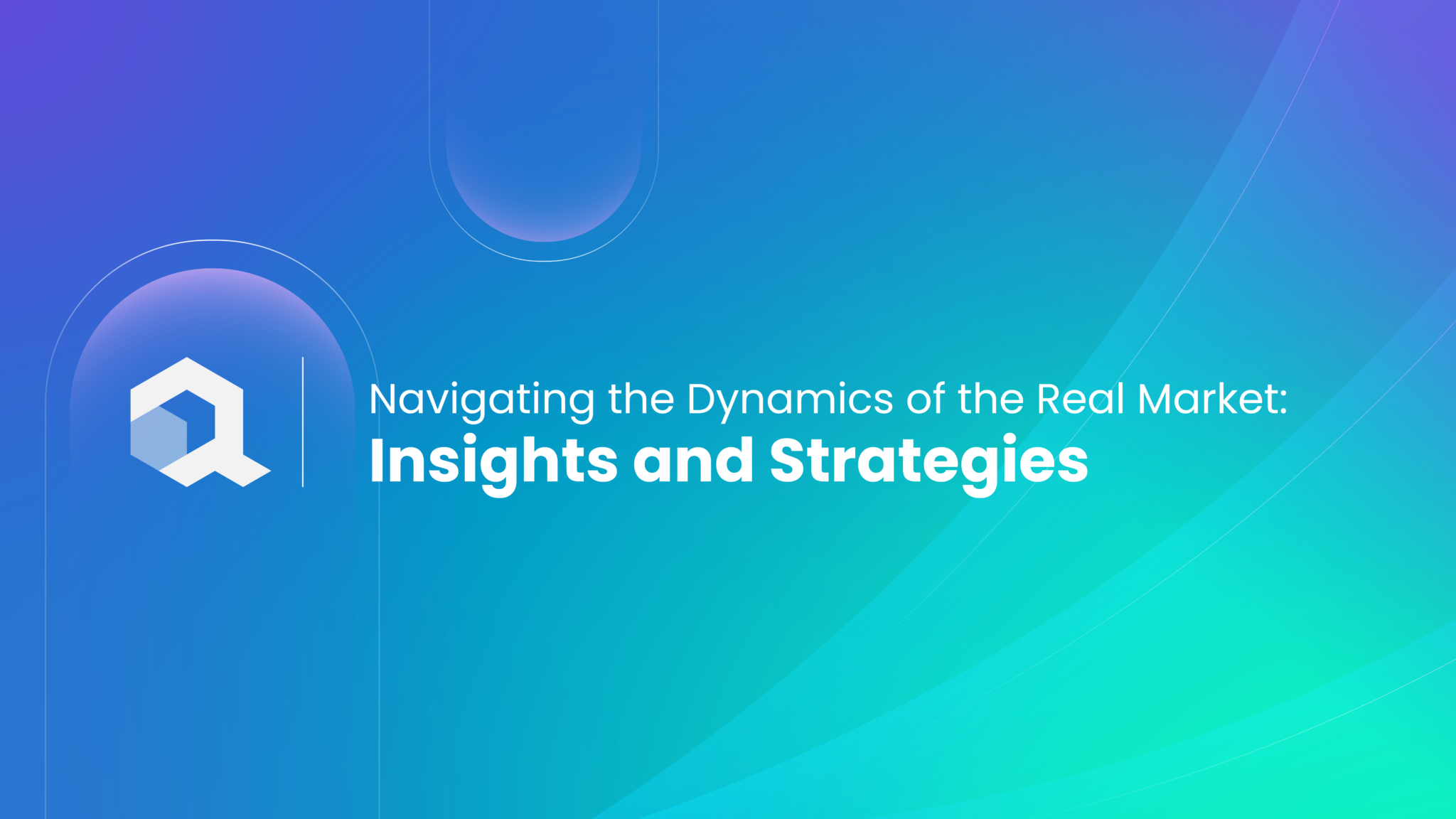
The global economy relies on the complicated and dynamic environment of the real market as one of its important elements. The other vital component of success in the fast-paced real market is adopting innovation. The need for resilient mindedness in an era of fast technological shifts, varied ways of consumer behavior, and ever changing business models. Technologies make companies and people who take measures to do business at less cost.
Adoption of technology not only improves productivity but can also be used as a tool for seeking new markets. These combine into confidence that one can navigate around for success in the real market. Smart people in business do not only respond to real market conditions but also influence their fate by being well-informed. Resilience entails being adaptable amid changing conditions and taking up opportunities that come along with challenges. It is important that people understand how it works for them to thrive in a challenging situation, which will also present opportunities. This article will focus on selected issues relating to the ‘real’ market, and we will provide suggestions and guidelines on how to do well here.
Overview of Real Market Trends and Shifts

Everything is changing now in terms of real market trends and shifts, touching any sector unexpectedly. The essence of this transformation revolves around the omnipresent digitization phenomenon, whereby industries have been quickly incorporating advanced technologies. Cloud computing, artificial intelligence, and data-analytics technologies are not just instruments; they rather take over business operations, building a new experience for consumers. Ecommerce’s constant war against conventional patterns of shopping requires extensive modernization of websites, shipping and final deliveries to suit today’s online customers.
Sustainability issues have become significant drivers of consumer tastes and business operations. Indeed, forward-thinking companies are incorporating eco-friendly sourcing, energy-efficient processes, and waste reduction strategies. There have been earth shattering changes in the paradigm of labor, made worse by Covid-19 induced global shocks. The new generation of work environments is demonstrated through the reassessment of required office space by companies and the adoption of advanced collaborative technology backed up with flexible employment strategies.
Also Read: Market Making: Strategies and Techniques
Telemedicine and health apps are the revolutionary changes taking place in the health tech sector. This change is reflective of a wider move towards more cost effective and remote health care solutions, which will reform how healthcare and services are acquired and given. The world’s move to sustainable energy is fueling a sizeable shift towards renewables. In a common effort to deal with this imperative, investments flow into solar, wind, and other alternative green sources.
Due to the accentuation of disruptions caused by a pandemic, supply chain resilience has become an essential element of strategic considerations. Businesses are now using multiple sourcing strategies coupled with technology to form sturdier supply chains that have less exposure to unexpected interruptions. To avoid the risks of external shocks in supply chain management, business entities are now embracing the strategy of multi-sourcing Traditional financial systems are challenged by the emergence of DeFi, which runs on blockchain. It evolves into cryptocurrencies, smart contacts, and blockchain financial services, redefining the way financial transactions are conducted.
Changing consumer demographics and preferences are impacting consumer behavior in general. Due to this changing terrain, companies must alter not only the design of their goods but also their marketing strategies as well as supply chain systems. Furthermore, geopolitical forces like trade uncertainties and changes exert extra complexities that affect delivery channels as well as the accessibility of markets. Adaptability and forward thinking strategies are therefore key to any business’s ability to succeed in this complicated environment that has been characterized by real market transformation tendencies.
6 Real Market Risk Mitigation

An essential element of business strategy is real market risk mitigation, which includes identifying, assessing, and managing threats to the continuity of work. Here’s a breakdown of key elements in real market risk mitigation:
1. Risk Identification and Assessment
Systematic identification and evaluation of potential risks that may affect a company form the first stage of successful risk mitigation. From an insider point of view, organizations examine processes, financial management and the structure of the organization for weaknesses. The impacts of externally-driven conditions like real market volatility, economic fluctuations, regulatory changes, and technological disruptions are strictly evaluated.
Doing this thorough testing allows companies to produce the most accurate risk profile, which shows how different dangers can threaten their stability. In this way, organizations will understand those risks, which require them to come up with strategies to reduce their effects and build resilient businesses. It would mean not only spotting today’s risks but also identifying tomorrow’s problems and providing a proper approach when dealing with reality.
2. Diversification Strategies
One of the strategies in risk management is diversification, where investments are spread over diverse assets, industries, and locations. The logic behind this approach is known as diversification, which does not focus on the potential weaknesses with respect to a particular industry or region. For example, diversity in an investing portfolio can involve different types of securities, such as shares, debts, and materials, to balance risks and yields accordingly.
Business activities can help minimize the effect of some negative occurrences on a specific area by varying product lines and moving into other markets. Diversifications ensure that companies do not encounter risks that cannot be shared and thus offer chances of growth when entering different markets. Although it can’t entirely eliminate risk, it provides a wise way to work with uncertainty—an aspect that plays a vital role in ensuring long-term stability and flexibility amid ever-changing market conditions.
3. Hedging Techniques
Businesses employ sophisticated hedging strategies in order to lessen the effect of unfavorable markets. For instance, through the application of financial tools such as futures, options, and derivatives that shield companies from price changes in oil, foreign currencies, or interest rates. For example, a commodity dependent firm can use future contracts to lock in prices, bringing some stability to its costs.
By adopting this strategic approach, businesses set standards for various forms of uncertainty arising due to the instability of a world of increasing risks and uncertainties. Hedging may be expensive, but it proves to be an essential risk management tool that may assist in dealing with uncertainty, ensuring stable financial forecasts, and guarding margins.
4. Supply Chain Resilience
In order to sustain interconnected global markets, there is a need to build a resilient supply chain. Such a strategy includes the spreading of suppliers so as not to be over-reliant on one supplier. Inventory should be kept at optimal levels in order for a firm to sustain interruptions without affecting its ability to serve its customers.
The strategy revolves around technology that provides instant visibility within the supply chain and allows fast responses to changed demands or unexpected risks. Supply chain resilience became important when companies across the world experienced the effects of the COVID-19 outbreak. A resilient supply chain enabled those entities to adjust to this changing environment, thereby sustaining operations without serious hitches. A resilient supply chain is much more than risk reduction; it’s delivering product quality that meets customer expectations in an uncertain environment.
5. Scenario Planning
Businesses utilize scenario planning, which is a strategic tool, in anticipation of different possible future scenarios. It is a future-oriented examination in which scenarios are constructed and their effect on operations is estimated. Through imagining alternative realistic prospects, organizations may create and implement alternative adaptive measures, which could help address multiple threats.
The use of the framework improves organizational agility while providing the predictive capacity necessary for making good decisions. Contrary to typical risk management, scenario planning fosters a pro-active approach and equips firms with increased agility to face uncertainty. Organizations use it as a handy asset to foresee not only probable but even unanticipated disturbances.
6. Market Intelligence and Research
Proactive mitigation of risk includes continuous real market intelligence and research. To ensure that companies make the right decisions regarding these, they have to be well informed of the current real market outlooks, competitors’ actions, and other industry affairs. This entails the systematic collection of data, followed by its analysis and interpretation for the identification of possible risks and possibilities.
Businesses should always predict the trends being shaped by the changes in the real market landscape to adjust accordingly and retain their edge in the market. Strategic decision making requires real market intelligence and research in advance so that a business can spot risks before they happen and take advantage of the new chances. Nowadays, advanced analytics combined with artificial intelligence will help gain more insights into real-time real market intelligence that will give them an edge over other players competing in similar markets.
Real Market Global Perspectives

A complex and diverse world, encompassing multiple intersecting forces whose impact shapes global real market dynamics. Globalization has intensified real market links and turned them into a highly complicated network where economic phenomena in one area may cause spillover impacts in other countries. These trade relations become powerful real market trend shapers for world markets and have lasting influence on industries all around the globe. Emerging markets, such as countries with fast-growing economies, technological innovations, and shifting populations, can create a special kind of attraction because of the unusual chances for high revenues or other positive changes worldwide.
Of course, fluctuations in foreign exchange are another thing not to forget, as they continue to shadow all the foreign trade and asset pricing issues at all times. The broad economic indicators of global economic activity, such as more complex measures like GDP rate, inflation levels, and unemployment, reflect the condition of economies around the world. These signposts help guide decisions; however, it is not only on an isolated basis of what happens in a region alone but rather within our global economy.
Also Read: Market Maker Options: Definition and How They Make Money
Technology innovations and disruptions are often beyond boundaries; they disrupt industries and bring forth new global possibilities in this century. In fact, the focus on ESG issues is increasing all over the world, greatly influencing how investments are made and shaping the direction in which markets develop. This makes it even more complicated, and businesses have to manage the various regulatory laws in every country of operation.
Even the world stage cannot be spared from such shocks as pandemics and political crises with long term effects on the whole globe. With such uncertainties, businesses must be flexible and adaptable, thus implying the need for a strong crisis management strategy. This further complicates issues as culture specific subtleties, including numerous patterns of consumption, call for individualized and context-specific approaches by companies that strive to connect with specific target groups.
Demographic changes such as population growth rates, ageing populations, and processes of urbanization present opportunities and challenges that impact global markets across the world. Stock exchanges, commodities markets, and bond markets, in particular, provide a constant connection between financial markets that serve as a pulse for global economic activity. This underlines the fact that businesses should see global financial markets as an interdependent whole when operating in a constantly changing world economy.
In today’s world of real markets, a global perspective is required to go beyond just superficial acknowledgement of how many economies affect each other through trade, technological change and all sorts of sociocultural matters. Those businesses with a global perspective stand in a better position to exploit opportunities while reducing the risks that exist in the ever-changing global business environment. These traits and holistic understanding are very crucial for surviving the complex and ever-changing fabric that comprises today’s economy.
Conclusion
In many cases, success in the real market rests on a delicate blend of foresight, research, and flexibility. This is because, in an evolving landscape, having updates on global perspectives becomes crucial. This entails more than just watching over existing real market happenings; it also involves the long-term factors influencing economies and global industries. Strategic foreseeing is crucial for proactiveness by helping people and companies put themselves ahead of trends and challenges.
Success hinges on diligent research. It is more than just about spotting real market trends; it covers an in-depth analysis of political and sociological issues that influence real market tendencies. Strong research provides information that will help people and businesses make judgments on possible future opportunities as well as perils. The ability to sort out large datasets, identify meaningful inferences and use them appropriately can make a critical difference in this information age.
One thing that organizations must consider in the real world is risk management, as it helps them navigate the uncertainties of the real market. There will always be surprises—be it recession, international strains, or worldwide catastrophe. Such successful people and companies strategically anticipate a variety of risks by maintaining diverse portfolios, financial instruments, and contingencies. This anticipatory strategy helps organizations overcome any possible negative situations and take advantage of chances that come up in tough conditions.
Disclaimer: The information provided by Quant Matter in this article is intended for general informational purposes and does not reflect the company’s opinion. It is not intended as investment advice or a recommendation. Readers are strongly advised to conduct their own thorough research and consult with a qualified financial advisor before making any financial decisions.

I craft stories that make complex ideas clear. I simplify the blend of data science, machine learning, and crypto trading, showcasing how advanced tech and quantitative models analyze data for informed trading choices. Join me in exploring the realm of quantitative trading, where my narratives make intricate concepts easy to grasp.
- Alifia Berizkyhttps://quantmatter.com/author/alifia-berizky/
- Alifia Berizkyhttps://quantmatter.com/author/alifia-berizky/
- Alifia Berizkyhttps://quantmatter.com/author/alifia-berizky/
- Alifia Berizkyhttps://quantmatter.com/author/alifia-berizky/
